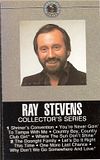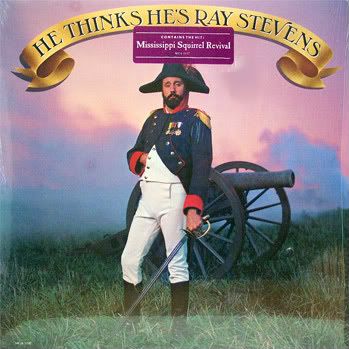
I don't have this particular LP in my possession but I like the picture on the album and I believe it was issued in 1975 or 1976...I see that "Misty" is one of the songs on the LP and that was a single in 1975 and so I'd say the album was released at some point in the mid 1970's. The photo of Ray was a publicity picture for several years. One of the unique traits about Ray happens to be the Clyde ring he often wore. This picture has appeared on various other compilation projects including a massive collection that was issued in 1979 called
The Ray Stevens Greatest Hits Collection which has a different album design but the same picture is used. That LP was issued on the Pickwick label. I have not looked at a lot of recent pictures of Ray's hands to see if he still wears the Clyde pinky ring or not. Clyde, of course, is the name of the famous camel in his 1962 hit "Ahab the Arab".

A lot of record labels have released compilation albums on Ray Stevens through the years. It's one of the more puzzling things that I've ever seen. There are at least 40 albums from a wide variety of labels both major and independent that have issued "greatest hits" and "best of" collections on Ray. I say 40...and that's an estimate...there are probably way more than that. The reason for this kind of thing may depend on the label's themselves. Ray recorded for what would be considered now an independent label, Barnaby Records, throughout the majority of the 1970's. 1970-1975 to be exact. Their distribution as I discussed in a previous blog was handled by CBS Records followed by other distributors in 1973. The songs on
The Ray Stevens Greatest Hits Collection are as follows...as you can tell by the amount of songs, it was issued as a double album, 2 LP's:
1. Everything Is Beautiful
2. Nashville
3. Mr. Businessman
4. Little Egypt {album track}
5. Sir Thanks-A-Lot {album track}
6. Turn Your Radio On
7. Misty
8. Don't Boogie Woogie {album track}
9. Gitarzan
10. The Moonlight Special
11. Sunshine {album track}
12. Ahab The Arab
13. Bridget The Midget
14. Isn't It Lonely Together {album track}
15. Unwind
16. You've Got The Music Inside {album track}
17. Just So Proud To Be Here {album track}
18. Along Came Jones
19. The Streak
20. All My Trials
21. Have A Little Talk With Myself
22. Sunday Mornin' Comin' Down
23. Freddie Feelgood
24. Lady Of Spain {album track}
A lot of the songs on that collection, as well as many of the other "hits" collections out there on Ray, contain songs that were never even released as singles. I touched upon this in a previous blog entry. There are quite a few album songs among the 24 tracks I posted above. The funny thing is, though, they all sound like actual hit songs...and I feel that this is due to the repetitious inclusion of many of them on various "greatest hits" projects through the years. It's like a lot of the album songs that have been featured on countless hits collections gain just as much fame and popularity among Ray's fan base as the actual hit singles do. I think that this sort of thing helps create familiarity among the fan-base. For instance, a new fan is introduced to vintage Ray Stevens material by the various hits compilations about there and since a lot of his material is out of print, it's a plus when labels add in non-hits because it gives exposure to songs not typically spotlighted. In 1997 Rhino Records released
The Best of Ray Stevens. My copy is about worn-out...but I'm not getting rid of it because it has some good liner notes from Dr. Demento, a DJ who plays novelty songs on a 2 hour radio program. The publicity picture of Ray that I've been writing about in this blog appears in the pages of the liner notes and appears on the back of the CD cover underneath the list of songs and producer credits. 1997 was the 40th anniversary of Ray's first recordings.
Fast-forward to 2001. Varese Sarabande, an independent label that issues out-of-print LP's and songs onto CD, issued a 23 track collection on Ray titled
All-Time Greatest Hits. The cover photo is the same one you see here but there's a yellow tint covering the image...it's okay...but I'd prefer they leave the photo the way it appeared on the album above.

The Varese Sarabande CD with the yellow tint over Ray's photo contained 23 songs, with the highlight being a couple of songs that rarely appear on compilation projects done on Ray. First there was the inclusion of his feel-good Top-40 country hit, "Everybody Needs a Rainbow", which I love...and another highlight is "Sgt. Preston of the Yukon", his 1960 single that nearly got him into trouble with King Features Syndicate over his using the Sgt. Preston character without their permission.
Getting back to the pinky ring...

This picture of Ray comes from 1988. He is performing his 1980 single, "Shriner's Convention". There is no pinky ring in this performance...but that doesn't mean he stopped wearing it. But I happen to think the ring was just a piece of jewelry he wore during the 1970's and early 1980's and eventually stopped wearing...maybe it became too tight? Isn't it interesting what topic I eventually end up writing about!?!?










